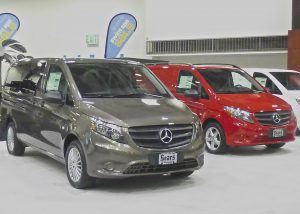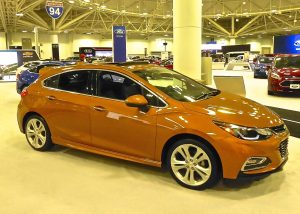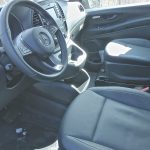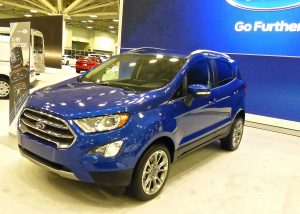Metris offers new reasons to tour auto show
By John Gilbert
When the Twin Cities Auto Show arrived on the same weekend as the Minnesota state high school hockey tournament, I knew I’d find a way to get to both events, even though they are separated by the 10 miles from the Minneapolis Convention Center to St. Paul’s Xcel Energy Center ice arena.
The Twin Cities Auto Show, scheduled through March 19, is not one of the nation’s major shows, more of a dealer-oriented and operated show with vehicles contributed by the regional dealerships, and without the Detroit-Chicago-L.A.-New York displays of concept cars and futuristic things. The theme is similar, however, with an emphasis on trucks and SUVs, and reflecting the nation’s sudden urge for compact crossovers (CUV), and electrified vehicles.
The “Car of the Show” was the new Chevrolet Cruze Coupe, and after strolling through the dozens of Chevrolets looking for a two-door Cruze, I asked somebody and learned that the “Coupe” term is in roofline silhouette only, which other manufacturers call “Four-door coupe” styling.
Aside from drawing the scorn of our new President Trump for having the audacity to build the Cruze Coupe in Mexico, instead of the United States, Chevrolet has designed a winner with the Cruze Coupe, which has a neat style and a fastback roofline that ends in a hatchback.
While I never tire of strolling among a lot of new cars at any auto show, I had a couple of specific reasons for my search at the Minneapolis Convention Center. I had been doing a test drive on a 2017 Mercedes Metris that week, and I was quite curious about that vehicle, spooky as it was handling a light snowfall on top of some serious melt-then-freeze ice in my driveway.
The Metris has a front engine with rear-wheel drive, which is not the right prescription for driving through Duluth, MN., in wintertime in any reasonably competent manner. But I made it.
The Metris also comes two ways — as a cargo van, or a passenger van. I wound up with the cargo van, which meant no seats back of the driver-passenger pair up front, and no windows in the back walls. Still, the Metris performed well, with a -liter dual-overhead-cam 4-cylinder turbo engine, and a 7-speed automatic transmission that could be operated with steering wheel paddles. That amused and amazed me, because a lot of sporty cars don’t have paddles, and here was a windowless cargo van, plain as could be, with paddles.
Then I stepped on it once when some approaching freeway traffic was getting closer sooner, and the Metris took off like a drag-racer! I ran it through the gears with the paddles, and I was very impresed by its performance. It functioned so well that I wanted to check out the passenger van for comparison. I found a couple of them parked alongside each other at the Twin Cities show. The passenger van has impresive rows of seats and windows, with the same drivetrain.
Mercedes makes the Sprinter, a larger than van-sized van, which is perfect for converting into a mini motorhome. It is powered by either a 4 or V6, diesels both, ranging from 181 to 188 horsepower and from 266 to 325 foot-pounds of torque.
The smaller, more compact, and sleeker Metris has 208 horsepower and 258 foot-pounds of torque from its comparatively small 2.0 gas engine, because the turbocharger can be tweaked to whatever you need. That’s one of those intriguing engines that is somewhat jointly designed and built with Nissan, and versions of it can be found in assorted Infinitis as well as Mercedes sedans, coupes and SUVs.
The show has a Camp Jeep display where you can see how high you can climb, and even how easy it is to scale a five-step staircase. It has an electric room to check out various electric cars, as well s a luxury lane and other specialty areas. But the best viewing is to have an idea of some of the just-introduced new stuff.
I checked out the Volvo XC-60 and the V90 wagon, and the various new Honda, Toyota, Nissan, Subaru and Mazda vehicles. Also, the new Ford EcoSport, its new smaller-than-Escort CUV that looks interesting.
The Jeep Compass is another new product, completely redesigned, where I thought Jeep might drop it from existence because it has the Cherokee above it and the Renegade below it. But there it is, looking good, like a downsized Grand Cherokee. I’ll be reporting on the Compass after another week-long road test.
Kia has its new Niro, a 50-plus-mpg hybrid powered by the very strong 1.6-liter 4-cylinder and an electric battery pack — but with no available AWD at introduction time.
Some of my favorite vehicles are the new-breed Lexus sporty CUVs, some with hybrid powertrains and new small but potent gas engines.
Same with Nissan, which has its own and its Infiniti brand CUVs — my favorite of which is the new QX-30. On the Nissan side is the new Rogue Sport, which is a foot shorter than the standard, and very popular, Rogue crossover, with good head and legroom and only reduced storage.
Mazda remains high on my list of new vehicles too, with high-tech Skyactive engines and now with G-vectoring steering-handling technology. The new Mazda3 and Mazda6 sedans look outstanding, and the SUV range now includes the large CX-9, the midsize CX-5, and the compact CX-3, which is a great size, but maybe a little too cramped in the rear seat.
While looking at Asian vehicles, don’t pass up Hyundai and Kia, which have impressive cars from subcompact to large, and a similar stock of SUVs from compact to large. Plus, their new engine and transmission technology promises excellent fuel economy, and they are going to new hybrid systems for 2017.
Volkswagen has its new Atlas large SUV, and you can examine the Tiguan, restyled and lengthened to be larger than the stubby but efficient original. Check also the Jetta with the 1.4-liter 4-cylinder, from a new family of engines, turbocharged for high performance as well as high mileage.
While I await the Alfa Romeo Giulia that was supposed to be headed my way for a test but was intercepted by some pre-production glitches that needed attention, I was able to look one over at length at the show and enhance my impatience for the car.
There are plenty of exotic cars, too, although among my favorites are the Jaguar and Land Rover display, which are now jointly owned by Tata Motors of India. They have built new powerplants, and they both make use of a high-tech 2.0-liter 4 as well as larger engines, including supercharged models. The new Jaguars are, in a word, spectacular, including the new F-Sport SUV and XE sports sedans.
Then, of course, there are enough pickup trucks to fill a normal sized hall on their own. You can find them in assorted sizes at Ford, Chevrolet, GMC, and Ram, but don’t forget to also check on the Honda, Nissan and Toyota locations. As for SUVs, a good project would be to see which company has more SUVs of various sizes, because every company that has huge, normally large, full-size, mid-size, and compact SUVs is now scrambling to produce compact crossovers.
My theory is that even if President Trump follows through abandoning the stiffer EPA regulations which can produce high-mileage concepts, and we go back to larger, more-foul, and lower-mpg engines, it’s still going to be a major attraction to find a good-handling, modestd-sized CUV that will get over 30 mpg.
And if you get a small-enough CUV, you could always stow it in the rear of your Mercedes Metris, and hit the road.









 John Gilbert is a lifetime Minnesotan and career journalist, specializing in cars and sports during and since spending 30 years at the Minneapolis Tribune, now the Star Tribune. More recently, he has continued translating the high-tech world of autos and sharing his passionate insights as a freelance writer/photographer/broadcaster. A member of the prestigious North American Car and Truck of the Year jury since 1993. John can be heard Monday-Friday from 9-11am on 610 KDAL(www.kdal610.com) on the "John Gilbert Show," and writes a column in the Duluth Reader.
John Gilbert is a lifetime Minnesotan and career journalist, specializing in cars and sports during and since spending 30 years at the Minneapolis Tribune, now the Star Tribune. More recently, he has continued translating the high-tech world of autos and sharing his passionate insights as a freelance writer/photographer/broadcaster. A member of the prestigious North American Car and Truck of the Year jury since 1993. John can be heard Monday-Friday from 9-11am on 610 KDAL(www.kdal610.com) on the "John Gilbert Show," and writes a column in the Duluth Reader.